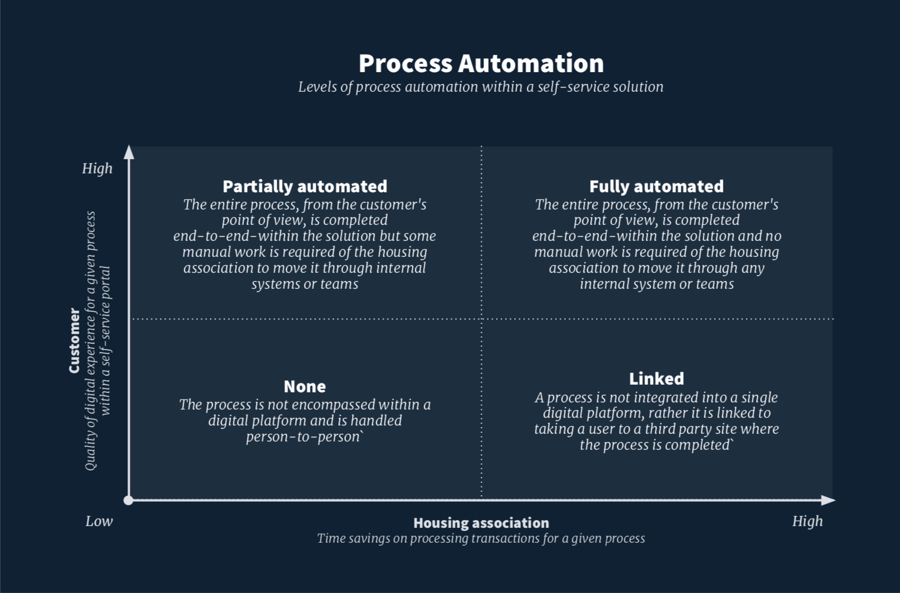Integrating third-party platforms can be convoluted and complex, but it really doesn’t have to be. The sheer volume of tenant data held in your housing systems and the hundreds of different processes currently in place around that data undoubtedly require careful handling, however, once you understand the integrations options available to you, you can focus on the most important thing: your tenants.
A good example of where a housing association would need to integrate third party systems is when implementing a self-service portal. In this instance, there can be multiple systems in use within your organisations that are provided by third party vendors which need to be integrated with the portal (itself often provided by a further third party) in order to be able to offer self-service to tenants.
Often with these type of projects, the housing association IT team isn’t actually doing the physical integration work, but facilitating a workable relationship between vendors which in and of itself can often be challenging!
In any case, whether you are integrating with a housing management system or CRM which contains all your tenant data, an EDRM containing tenant documents, a DRS system linked to repair contractor diaries or a payment provider that processes rent transactions there are several integration options to think about which may or may not be available from your current vendors.
Direct API integrations
Put simply, an API (Application Programming Interface) is a standardised set of instructions that defines how one piece of software can interact with another in real time.
When it comes to linking up third party systems to each other, doing so via an API integration is your ideal scenario because it’s faster, more secure and allows for completely up-to-date information to be shared with and by the connected platforms.
For example - if a housing management system and portal were connected via an API and a tenant updated their phone number via the portal, this could instantly be updated in the housing management system. Equally, if a repair status was to change from pending to scheduled, the tenant would be able to see this change via the portal in real-time without having to call for an update.
If you are looking at API integrations as an option, try to get as much documentation as possible from the system vendor you’re wanting to integrate as early as possible to enable a smoother process. Or even better - get the different suppliers involved to talk to each other! Open communication between them will be the easiest way to make the integration work.
Unfortunately, direct API integrations are not always possible, especially with some of the more traditional housing systems that are still in use within the space. APIs may not be available, be poorly documented or unreliable, require a lot of time to build or carry with them a significant cost to use. If you find this is the case, there are other avenues to explore.
Indirect integrations
It may be possible to get around the need for an API (if your vendor systems allow it) by using an alternative method of getting at your data. If you’re considering any of these options, it may be wise to check the terms of use with your current vendors to ensure that you’re not breeching your agreement by going down one of these routes.
Middleware
This is software that acts as a bridge between software platforms. These will often have pre-existing APIs that portal suppliers can integrate with and connectors that can link to your housing systems,. More often than not, it’s standardised so can be easier and faster to work with however, it does involve additional costs which you will need to consider in your budgets
A direct connection to database
Can you access the database currently running your housing systems? Often these are simply a SQL database you host on-premise. If so, there may be an opportunity for the third party to integrate directly with the data, cutting out the middleman and still allowing real-time data transfer between systems. One drawback of this method that it’s a workaround, so there’s likely to be very little documentation on the structure of the database so it may take longer to do!
Importing or exporting the data
Importing / exporting data directly from your housing system is another possible alternative. If you can extract the data in a CSV format or your own SQL database, you could import it to the portal on a scheduled basis - it may not be instant, real-time data but will allow you to enable access to online services.
If no integration is possible…
Some systems simply don’t offer any integration options. Even some of the most prominent payment providers in the housing space don’t offer ways to integrate with their systems, forcing an offsite link to be used instead, despite technology being available to make full integrations possible.
Whether this is down to the common misbelief that it’s not necessary for their business or that it’s an IT-only matter, you’ll have to weigh up what you want from your third-party integration. Tradeoffs for the user will have to be made, or you need to consider other systems.
If possible though, try to avoid embedding third party functionality via Iframe. An iframe is essentially a ‘hole’ in a web page that shows the content of another web page, hosted somewhere else, within it. They’re super-easy to implement and on the face of it can make your life a lot easier if you’re struggling with integrations but, crucially, they’re not very secure and they are not great for end users due to them not being responsive.
Summing up
At a fundamental level, the integration capability of your software platforms will directly affect the level of automation you are able to achieve by connecting the systems. For example - for a seamless self-service experience, there needs to be a degree of automation - there’s no point in a maintenance request simply generating an auto-email only for it to drop into the service centre inbox to be dealt with on Monday anyway.

How much automation depends on the capabilities of your provider and your preferences. But any automation of a process via a customer facing system, like a portal, usually requires integration with your internal systems. Depending on the system, the level of automation you can offer might vary.
Inevitably, this will affect the benefits of the portal to the organisation. The less automation, the lower the quality of digital experience the customer will receive within a self-service portal, and more time will be required from your housing association to process the transaction. But if you can offer a level of automation, the experience improves and less resource is required at your end.



.jpg)

